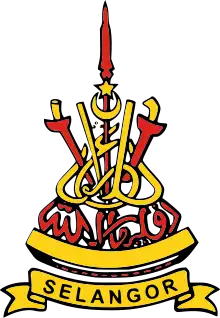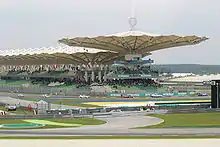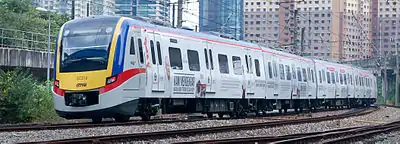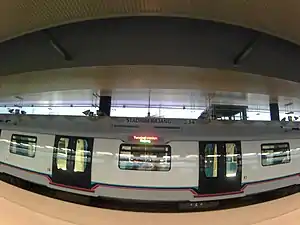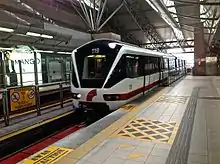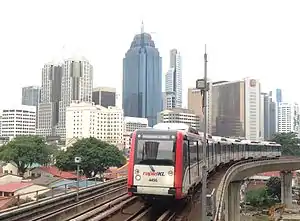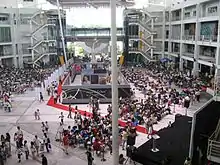Selangor
Selangor (/səˈlæŋər/; Malay: [s(ə)laŋo(r)]),[4] also known by its Arabic honorific Darul Ehsan, or "Abode of Sincerity", is one of the 13 states of Malaysia. It is on the west coast of Peninsular Malaysia and is bordered by Perak to the north, Pahang to the east, Negeri Sembilan to the south and the Strait of Malacca to the west. Selangor surrounds the federal territories of Kuala Lumpur and Putrajaya, both of which were previously part of it.
Selangor | |
|---|---|
| سلاڠور دار الإحسان
Selangor Darul Ehsan | |
| Other transcription(s) | |
| • Jawi | سلاڠور |
| • Chinese | 雪兰莪 (Simplified) 雪蘭莪 (Traditional) |
| • Tamil | சிலாங்கூர் |
| Motto(s): Dipelihara Allah [1] (By God's Protection) | |
| Anthem: Duli Yang Maha Mulia Your Royal Highness | |
 | |
| Coordinates: 3°20′N 101°30′E | |
| Capital | Shah Alam |
| Royal capital | Klang |
| Government | |
| • Type | Parliamentary constitutional monarchy |
| • Sultan | Sharafuddin Idris Shah |
| • Menteri Besar | Amirudin Shari (PH-PKR) |
| Area | |
| • Total | 8,104 km2 (3,129 sq mi) |
| Population (2018)[3] | |
| • Total | 6,448,400 (1st) |
| • Demonym | Selangorean / Selangorian |
| Human Development Index | |
| • HDI (2018) | 0.855 (very high) (2nd) |
| Time zone | UTC+8 (MST) |
| • Summer (DST) | UTC+8 (not observed) |
| Postal code | 40xxx to 48xxx, 63xxx, 640xx, 68xxx |
| Calling code | 03 |
| ISO 3166 code | MY-10 |
| Vehicle registration | B |
| Federated into FMS | 1895 |
| Japanese occupation | 1942 |
| Accession into the Federation of Malaya | 1948 |
| Independence as part of the Federation of Malaya | 31 August 1957 |
| Website | www www |
The state capital of Selangor is Shah Alam and its royal capital is Klang. Petaling Jaya and Subang Jaya received city status in 2006 and 2019, respectively.[5] Selangor is one of four Malaysian states that contain more than one city with official city status; the others are Sarawak, Johor, and Penang.[6][7]
The state of Selangor has the largest economy in Malaysia in terms of gross domestic product (GDP), with RM 239.968 billion (roughly US$55.5 billion) in 2015, comprising 22.6% of the country's GDP.[8] It is the most developed state in Malaysia, and has the largest population and the lowest poverty rate in the country.[9]
Etymology
The origin of the name Selangor is uncertain. A common suggestion is that the name refers to the Malay word langau, a large fly or blowfly that is found in the marshes along the Selangor River in the state's north-west. According to local lore, a warrior who escaped from Malacca after the Portuguese conquest, took a break from his journey north and rested under a tree here. However, he was disturbed by a persistent fly, whereupon he decided to explore the area. When he found the place to his liking and chose to settle there, he named the place "satu (se) langau" meaning "a large blowfly".[10][11]
In the absence of a firm etymological explanation, alternative theories abound. One suggestion is that the name may have originate from a kind of tree found in Kuala Selangor and along Selangor River named mentangau.[12] Another theory claims the state's name is derived from the term Salang Ur where ur means "town" or "village" in Tamil, meaning village of the Salang people.[10] It has also been proposed that the name is derived from a combination of salang (stabbing) and jemur (dry in the sun), indicating that it was once a place where traitors were stabbed (salang) then left to roast in the sun (jemur).[10]
History
| Historical affiliations | Period |
|---|---|
| 15th century-1510 | |
| 1511-1765 | |
| 1766–present | |
| 1895-1941 | |
| 1941–1945 | |
| 1946–1948 | |
| 1948–1963 | |
| 1963–Present |
Tho most important settlement of the area in the ancient period may have been Klang. Ancient artefacts including Bronze Age axes and bronze bell dating from the 2nd century BC,[13][14][15] and iron tools called "tulang mawas" ("ape bones") have been found in or near Klang.[16] The Mao Kun map dating to the Ming dynasty and used by the Admiral Zheng He during his voyages of expedition between 1405 and 1433 refers to places in Selangor such as the Klang River estuary (吉令港) and perhaps a hilly area.[17] The Malay Annals indicates that the Selangor area was under the control of the Sultanate of Malacca in the 15th century; however, Selangor at that time was not a unified domain—separate river states such as Klang and Jeram existed in the region.[16] According to the Malay Annals, Tun Perak was appointed the chief of Klang during the reign of Muzaffar Shah. Later, the son of Mansur Shah and Hang Li Po named Paduka Sri Cina was made raja of Jeram near Langat, which may be due to the presence of Chinese miners there.[16]
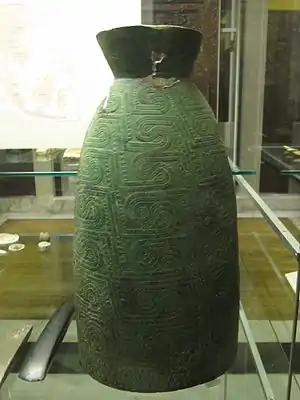
After the fall of Malacca to the Portuguese in 1511, the area came under the control of Johor Sultanate and was later governed by Sri Agar Diraja, son of the Bendahara family of Johor.[18] In the 17th century, Johor was involved in a war against Jambi, and the Sultan of Johor engaged the help of Bugis mercenaries from Sulawesi to fight against Jambi.[19] After Johor won in 1679, the Bugis decided to stay and started to gain power in the region.[20] Many Bugis began to migrate and settled along the coast of Selangor such as the estuaries of Selangor and Klang rivers. Some Minangkabaus may have also settled in Selangor by the 17th century, perhaps earlier.[21] The Bugis and the Minangkabaus from Sumatra struggled for control of Johor; Raja Kecil, backed by the Minangkabaus, invaded Selangor but were driven off by the Bugis in 1742. In order to establish a power base, the Bugis led by Raja Salehuddin founded the present hereditary Selangor Sultanate with its capital at Kuala Selangor in 1766.[22] Selangor is unique as the only state on the Malay Peninsula that was founded by the Bugis.[23]
In the 19th century, the economy of Selangor boomed due to the exploitation of its tin reserves; mining occurred in various parts of Selangor, for example in Ampang, that led to the growth of Kuala Lumpur. In 1854, the Sultan of Selangor granted Raja Abdullah control of Klang, passing over Raja Mahdi, the son of the chief who previously ruled Klang, which led to the Selangor Civil War fought between 1867 and 1874. The war between the Malay factions was also partly a struggle for control of the revenues from tin.[24] Tin mining had attracted a large influx of Chinese migrant labourers, and Chinese clans allied with Selangor chiefs also joined the civil war. The conflicts between Malay and Chinese factions in Perak and Selangor, as well as concerns over piracy that affected coastal trade, led to increasing British involvement in the affairs of the Malay states.[25]
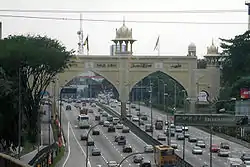
In 1874, Sultan Abdul Samad of Selangor accepted a British Resident in a system that allowed the British to govern while the Sultan remained the apparent ruler. Klang was the capital of the British colonial administration for Selangor from 1875 until 1880 when it was moved to Kuala Lumpur. Under the stability imposed by the British, Selangor again prospered. In 1896, largely through the coordination of the Resident Frank Swettenham, Selangor united with Negeri Sembilan, Perak and Pahang to form the Federated Malay States, with Kuala Lumpur its capital.[26]
The Federated Malay States evolved into the Federation of Malaya in 1948, which became independent in 1957. The federation became known as Malaysia in 1963, when its existing states federated with the other British colonies of Sarawak, North Borneo and Singapore. The city of Kuala Lumpur functioned as the national capital of Malaysia and as the state capital of Selangor. In 1974, Selangor relinquished Kuala Lumpur to the federal government.[27] The Sultan of Selangor commemorated the city's transfer by building an archway on the borders of the new Federal Territory and Selangor; this archway is the Kota Darul Ehsan that straddles a section of the Federal Highway between Bangsar and Petaling Jaya. The state capital was moved to Shah Alam after the cession.
Putrajaya, a new city designed to be the new administrative capital of Malaysia, was built by the federal government in Selangor; Sultan Salahuddin was asked again to cede land to the federal government.[28] Putrajaya became a federal territory in 2001.[29]
Geography
Selangor is located on the west of Peninsular Malaysia, overlooking the Straits of Malacca. The state is level on the west and hilly to the east. Selangor, with an area of approximately 8,000 km, extends to the west coast of Peninsular Malaysia on the north coast of Melaka. It is located at the heart of the Peninsular Malaysia on the west coast and surrounds the Federal Territory of Kuala Lumpur and Putrajaya. Selangor is bordered north by Bernam River from Perak, south by Sepang River from Negeri Sembilan, east by the Titiwangsa Mountains and Strait of Malacca on the west. Malaysia's capital, Kuala Lumpur is located in the heart of Selangor. It was once part of Selangor territory before it was ceded to the federal government to form a Federal Territory.
Selangor is divided into 9 districts namely Sabak Bernam, Kuala Selangor, Hulu Selangor, Petaling Jaya, Klang, Kuala Langat, Hulu Langat and Sepang.
Flora and Fauna
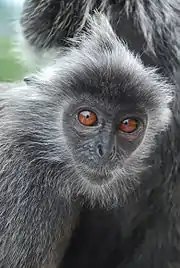
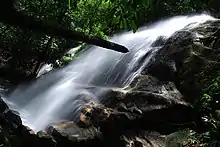
Malaysian forest can be classified as tropical rainforest. Selangor has 250,129 ha of permanent reserve forest, of which 82,890 ha are peat swamp forest and 18,998 ha formed mangrove forest along the coast. The permanent reserve forest makes up about 32 percent of the state land.[30][31] Ecoforests that are situated in Selangor are Gabai Waterfall, Taman Rimba Templer, Taman Rimba Ampang, Taman Rimba Komanwel, Sungai Chongkak, Sungai Tua, Sungai Sendat, Sungai Tekala, Kanching, Gunung Nuang and Bukit Tabur.[32][33] Reserve forest in Selangor is managed and conserved by the state's forestry department, as the National Forestry Act 1984 of the federal constitution provides that forestry comes under the jurisdiction of the respective state.[34] The Selangor's forestry department office is located at Sultan Salahuddin Abdul Aziz Shah Building in Shah Alam.[35]
Selangor is also home to a statutory agency of the Government of Malaysia, the Forest Research Institute Malaysia (FRIM). Located in Kepong, FRIM promotes sustainable management and optimal use of forest resources in Malaysia by generating knowledge and technology through research, development and application in tropical forestry.[36][37]
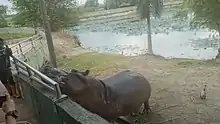
Selangor has a few declared protected areas (PAs) in order to safeguard biodiversity and wildlife. They are Sungai Dusun Wildlife Reserve which is first to be reserved to protect the Sumatran Rhinos,[38] Kutu Hill Wildlife Reserve,[39] and Bukit Sungai Puteh Hill Wildlife Reserve which is located at Kuala Lumpur and Selangor's border.[40] The state also has an ecotourism centre, Paya Indah Wetlands, which is located in the district Kuala Langat near Dengkil. It is a sanctuary to migratory and residential birds, Nile hippos and crocodiles.[41][42]
Climate
| Climate data for Selangor (LTSAAS) in 2017 | |||||||||||||
|---|---|---|---|---|---|---|---|---|---|---|---|---|---|
| Month | Jan | Feb | Mar | Apr | May | Jun | Jul | Aug | Sep | Oct | Nov | Dec | Year |
| Average high °C (°F) | 34 (93) |
35 (95) |
36 (97) |
36 (97) |
36 (97) |
37 (99) |
36 (97) |
36 (97) |
32 (90) |
32 (90) |
30 (86) |
31 (88) |
34 (94) |
| Daily mean °C (°F) | 31 (88) |
32 (90) |
32 (90) |
33 (91) |
33 (91) |
34 (93) |
33 (91) |
33 (91) |
30 (86) |
30 (86) |
28 (82) |
29 (84) |
32 (89) |
| Average low °C (°F) | 26 (79) |
26 (79) |
27 (81) |
27 (81) |
28 (82) |
27 (81) |
27 (81) |
27 (81) |
26 (79) |
26 (79) |
26 (79) |
25 (77) |
27 (80) |
| Average rainfall mm (inches) | 482.5 (19.00) |
296.2 (11.66) |
307.7 (12.11) |
289.0 (11.38) |
232.2 (9.14) |
127.1 (5.00) |
127.4 (5.02) |
213.8 (8.42) |
232.7 (9.16) |
102.2 (4.02) |
366.7 (14.44) |
319.9 (12.59) |
3,097.4 (121.94) |
| Average rainy days (≥ 1.0mm) | 28 | 28 | 31 | 27 | 31 | 24 | 29 | 31 | 24 | 21 | 30 | 31 | 335 |
| Average relative humidity (%) (daily average) | 78 | 78 | 77 | 76 | 75 | 72 | 71 | 74 | 75 | 72 | 82 | 79 | 76 |
| Mean monthly sunshine hours | 236.5 | 255.0 | 290.0 | 271.0 | 280.5 | 266.5 | 283.5 | 277.0 | 268.5 | 266.0 | 163.0 | 225.0 | 3,082.5 |
| Source: [43] | |||||||||||||
As in the rest of Malaysia, Selangor has a tropical rainforest climate (Köppen climate classification Af) bordering on a tropical monsoon climate. The climate is very much dictated by the surrounding sea and the prevailing wind system. It has high average temperature and high average rainfall.
Population and demographics
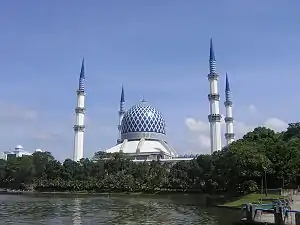
Selangor is Malaysia's most populous state; it has the nation's biggest conurbation, the Klang Valley. Selangor's geographical position in the centre of Peninsular Malaysia contributed to the state's rapid development as Malaysia's transportation and industrial hub, creating jobs and attracting migrants from other states and from other Asian countries, especially Indonesia, the Philippines, Vietnam, Myanmar, Bangladesh, India, Pakistan and China. In recent decades, an influx of illegal immigrants, particularly from Indonesia, has also contributed to Selangor's population.
Selangor's population has increased considerably in recent decades, due mostly to the development of the Klang Valley. The population was 1,426,250 in 1980, and by 2000 it had grown to 3,941,316,[44] and further increased to 5,482,141 in 2010.[45] As of 2015, its population was 5,874,100.[46]
Ethnic groups
| Ethnic Group | Population | |||
|---|---|---|---|---|
| 2010[45] | 2015[46] | |||
| Malay | 2,814,597 | 51.14% | 3,069,100 | 52.24% |
| Other Bumiputras | 62,657 | 1.14% | 77,500 | 1.32% |
| Bumiputra total | 2,877,254 | 52.48% | 3,146,600 | 53.56% |
| Chinese | 1,441,774 | 27.6% | 1,499,400 | 25.52% |
| Indian | 679,130 | 12.5% | 712,000 | 12.12% |
| Others | 42,163 | 0.80% | 41,400 | 0.72% |
| Malaysian total | 5,040,321 | 92.20% | 5,399,400 | 91.92% |
| Non-Malaysian | 421,820 | 6.82% | 474,700 | 8.08% |
| Total | 5,462,141 | 100.00% | 5,874,100 | 100.00% |
The traditional culture of Selangor's Malay majority is influenced by those of Bugis, Minangkabau, Mandailing and Javanese, Banjar, Rawanese and Bengkulu ancestry; most of whom are Muslims. Javanese ancestry was dominant in west coast districts such as Sabak Bernam, Kuala Selangor, Klang, Kuala Langat and Sepang. Selangor's population also includes ethnic Chinese and Indian influences; those two groups form the largest minority populations. The 3,000 Mah Meri people, part of the Orang Asli—the indigenous peoples of the Peninsula—can be found on Carey Island and maintain their culture and language while adapting to the modern way of life.[47] With its advanced state of development, Selangor has more international ties through trade, business and education than other rural states..
Religion
According to the 2010 census, the population of Selangor is 57.9% Muslim, 24.4% Buddhist, 11.6% Hindu, 3.8% Christian/Catholic, 1% of unknown affiliations, 0.5% adherent of Taoism or Chinese religion, 0.4% follower of other religions and 0.4% non-religious.[48] All Malays are necessarily Muslims because the definition of a Malay in the Malaysian constitution requires Malays to profess the religion of Islam.[49]
Politics
See also: Government of Selangor
The state is a hereditary constitutional monarchy, of which the reigning Sultan since 2001 is Sultan Sharafuddin Idris Shah. Since 19 June 2018, the Menteri Besar (chief executive of the state government) is Amirudin Shari, of the People's Justice Party (PKR) a component party of Pakatan Harapan (before, Pakatan Rakyat).[50]
Constitution
Consisting of 19 chapters and 100 articles, the Constitution of the State of Selangor is the highest form of law in the state. It came into force on 26 February 1959 and was separated into two parts. Under the 1959 constitution, Selangor is a constitutional monarchy.
Selangor Sultanate

The Sultan of Selangor is the constitutional Ruler of Selangor. The role, powers, and duties of the Sultan are set forth in the 1959 constitution, which proclaims that the office of Sultan is vested with the executive power of the state, are the head of the religion of Islam in the state and the "fountain of honours and dignities" in the state.[51][52] This position is hereditary and can only be held by a member of Selangor's royal family. The current ruler is His Royal Highness Sultan Sharafuddin Idris Shah, who has held this position since 2001.[53]
State Executive Council
The State Executive Council, which along with the Sultan is Selangor's executive branch of government, was established by the constitution of 1959. It is composed of the Menteri Besar—who is its chairman and Selangor's head of government—and ten other members; all of whom are appointed by the Sultan of Selangor from members of the State Assembly. The current Menteri Besar is Yang Amat Berhormat Dato' Menteri Besar Amirudin Shari.[50]
State Assembly
The state also has a legislative branch, called the Selangor State Assembly. It is similar to the Parliament but is limited to making laws relating to the state. Its members are elected, usually simultaneously with federal elections. The term of each state assembly member is limited to five years. The state assembly must be dissolved before or once it expires its term for a fresh election of its members.
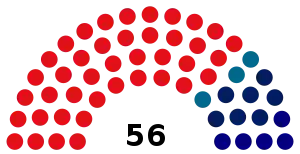 | |||||
| Affiliation | Coalition/Party Leader | Status | Seats | ||
|---|---|---|---|---|---|
| 2018 election | Current | ||||
| Pakatan Harapan | Amirudin Shari | Government | 51 | 42 | |
| Perikatan Nasional | Rizam Ismail | Opposition | 4 | 11 | |
| Government majority | 47 | 38 | |||
Administration
List of districts
| Number | Name | Population 2010 Census[54] | Area (km2) | Sub-districts | Note |
|---|---|---|---|---|---|
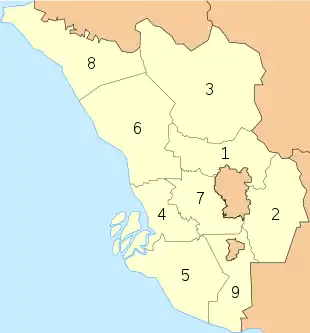 Administrative districts of Selangor. | |||||
| 1 | Gombak | 682,226 | 650.08[55] | Ulu Klang, Ampang, Setapak, Batu Caves, Selayang, Rawang, Taman Templer, Sungai Buloh, Kundang, Batu 20, Kampung Sungai Pusu | The meaning of Gombak is unknown but it is believed that the name comes from a village in Setapak called gombak (Gombak Setia). The district was created on 1 February 1974, the same day when Kuala Lumpur was declared a Federal Territory. Gombak is one of the few districts that has many cities and all of its sub-districts are cities except Batu 20, Kampung Sungai Pusu, and Setapak. Popular tourism places include Zoo Negara, Batu Caves, and Forest Research Institute Malaysia. |
| 2 | Hulu Langat | 1,156,585 | 829.44[56] | Kajang, Beranang, Cheras, Hulu Langat, Hulu Semenyih, Kelanang, Tanjong 12, Tarun, Sungai Makau, Sungai Lui, Sungai Kembong Beranang, Sri nanding, Simpang Balak, Rumah Murah Sungai Lui, Kampung Sungai Tangkas, Kacau, Kampung Pasir Batu 14 Semenyih, Desa Raya, Sungai Raya, Batu 26, Batu 23. | The name Hulu Langat means the beginning of Langat River. Hulu Langat has many major cities which are mostly located in the north of the district, such as Cheras and Kajang. Popular tourism places includes Sungai Congkak Recreational Forest[57] and Gabai River.[58] |
| 3 | Hulu Selangor | 198,132 | 1,740.46[59] | Kuala Kubu Bharu, Sungai Chick, Ulu Yam, Ulu Yam Baru, Kerling, Kuala Kalumpang, Sungai Gumut, Serendah, Peretak, Sungai Choh, Bukit Beruntung, Bukit Sentosa | The name Hulu Selangor means the beginning of river of selangor. Hulu Selangor have a city but majority of the settlements in the district are villages. The district is still largely covered with forests. Popular tourism places include Bukit Kutu,[60] and Kerling Hot Spring.[61] |
| 4 | Klang | 861,189 | 626.78[62] | Klang, Kapar, Bukit Raja, Port Klang, Pandamaran, Telok Menegun, Taman Sri Muda, Kota Kemuning, Bukit Kemuning, Batu 4. | The origin of the Klang name is unknown. The Royal Town of Klang, which is also the former capital of the state. Port Klang played major rolled in Malaysia economy. There are many popular tourist hotspots in the district, such as Istana Alam Shah, Klang Royal Town Mosque, Sultan Abdul Aziz Royal Gallery, Tanjung Harapan, Pulau Ketam and Little India.[63] |
| 5 | Kuala Langat | 224,648 | 858[64] | Bandar Saujana Putra, Jenjarom, Kanchong Darat, Sijangkang, Tongkah, Teluk Datok, Telok, Sungai Raba, Morib, Permatang Pasir, Kelanang Batu 6, Kanchong, Chodoi, Bukit Changgang, Batu, Jugra | Kuala Langat name derives from the combination of the word "Kuala" (river confluence) and Langat (from the Langat River). |
| 6 | Kuala Selangor | 209,590 | 1,194.52[65] | Api-api, Kuala Selangor, Bukit Melawati, Ijok, Kampung Kuantan, Kuala Sungai Buloh, Pasangan, Ulu Tinggi, Ujong Permatang, Tambak Jawa, Taman PKNS, Sungai Sembilang, Simpang 3 Ijok, Pasir Penambang, Simpang 3, Parit Mahang, Kg. Baru Hulu Tiram Buruk, Bukit Talang, Bukit Belimbing. | The word "Kuala" means the meeting between two or more river while the word Selangor comes from the name of the river located in the district, Selangor River.[66] The combination of two words generates the name Kuala Selangor.[67] Popular place to visit includes Bukit Melawati,[68] Kuala Selangor Nature Park and Kampung Kuantan Fireflies.[69] |
| 7 | Petaling | 1,812,633 | 484.32[70] | Petaling Jaya, Subang Jaya, Shah Alam, Damansara, Bandar Sri Damansara, Country Heights, Puchong, Puchong Jaya, Puchong Perdana, Batu Tiga, Sungai Besi, Serdang, Glenmarie, Penaga, Merbau Sempak, Kayu Ara, Desa Puchong. | The name Petaling comes from an extinct species of tree called Petaling.[71] Petaling has many major cities such as Petaling Jaya, Shah Alam, and Subang Jaya. Popular tourism places include Sultan Salahuddin Abdul Aziz Mosque, Bandar Sunway, and 1 Utama |
| 8 | Sabak Bernam | 105,777 | 997.1[72] | Sabak, Sungai Besar, Sekinchan. | The name Sabak Bernam comes from the story that this place is opened by six friend (Malay : Sahabat berenam).[73] Sabak Bernam main economic activity is agriculture and it is popular for its paddy fields especially in Sekinchan.[74] |
| 9 | Sepang | 211,361 | 599.66[75] | Puchong, Bukit Puchong 2, 16 Sierra, Taman Putra Prima, Taman Mas, Taman Putra Perdana, Taman Meranti Jaya, Pulau Meranti, Cyberjaya, Dengkil, Beranang, Salak Tinggi. | The name Sepang is taken from a tree called Sepang.[76] Popular tourism places include Sepang International Circuit, Kuala Lumpur International Airport and Cyberjaya. |
List of local authorities
There are 12 local authorities in Selangor,[77] namely:
- Majlis Bandaraya Petaling Jaya (MBPJ)[78]
- Majlis Bandaraya Shah Alam (MBSA)[79]
- Majlis Bandaraya Subang Jaya (MBSJ)[80]
- Majlis Daerah Hulu Selangor (MDHS)[81]
- Majlis Daerah Sabak Bernam (MDSB)[82]
- Majlis Perbandaran Ampang Jaya (MPAJ)[83]
- Majlis Perbandaran Kajang (MPKJ)[84]
- Majlis Perbandaran Klang (MPK)[85]
- Majlis Perbandaran Kuala Langat (MPKL)[86]
- Majlis Perbandaran Kuala Selangor (MPKS) (Starting 1 March 2021)[87]
- Majlis Perbandaran Selayang (MPS)[88]
- Majlis Perbandaran Sepang (MPSepang)[89]
Economy

The economy of Selangor is a progressive market economy whose core sectors are commerce and agriculture. Selangor is the richest state in Malaysia in terms of gross domestic product (GDP) per capita (PPP).[90] On 27 August 2005, Selangor was officially declared the first developed state in Malaysia by the state government.[91][92][93] Selangor has the highest Human Development Index among the states in Malaysia.
Commerce and industry
Commerce, industry and services are a major contributor to the economy of Selangor, accounting for over 58% of the state's GDP. Several industrial sites produce electronic goods, chemicals and vehicles including Proton and Perodua cars.[94][95][96] Imported vehicles from manufacturers including Toyota, Nissan, Volkswagen and BMW Motors are also assembled in the state.[97][98][99][100][101][102][103]
Many international manufacturing companies have set up bases here. Among the industrial cities in Selangor are Subang Jaya, Shah Alam, Klang, Kajang, Rawang, Selayang, Ampang Jaya and Petaling Jaya. Port Klang plays a key role in the industrial development of Selangor because it is the busiest port in Malaysia.[104][105]
The services sector is the second largest contributor to GDP, accounting for 60.1% of the state's GDP.[106]
Agriculture
Agriculture, a thriving sector of Selangor's economy, contributes 1.4% of the state's GDP.[106] Significant crops grown in the state are star fruits, papayas and bananas.[107] Selangor is not a major producer of rice; however, paddy fields exist in Kuala Selangor and Sabak Bernam.[108] Other agricultural activities in the state include the establishment of palm oil and rubber plantation sites.[109][110]
Tourism
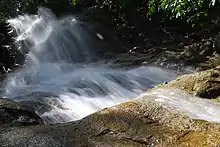
Tourist attractions in Selangor include the I-City in Shah Alam, a retail and commercial hub with millions of LED lights and an indoor park;[111] the National Zoo of Malaysia (Zoo Negara) in Ampang Jaya, the largest zoo in Malaysia with more than 4,000 animals;[112] Sepang International Circuit in Sepang, the venue for the Formula One Malaysian Grand Prix, the A1 Grand Prix and the Malaysian Motorcycle Grand Prix;[113] the Sultan Salahuddin Abdul Aziz Shah Mosque;[114] Wat Chetawan and Sunway Lagoon in Bandar Sunway, Malaysia's top theme park.[115]
Other attractions in Selangor include Batu Caves in Selayang, Shah Alam Gallery and Selangor State Library in Shah Alam, the Sultan Abdul Aziz Royal Gallery, Alam Shah Palace, GM Klang Wholesale City, and Crab Island (Pulau Ketam) off Port Klang. The most popular beaches in Selangor are located at Bagan Lalang, Sepang Gold Coast, Batu Laut Beach and Morib Beach. There are also a number of pristine nature sites such as the Firefly Sanctuary,[69] Kuala Selangor Nature Park in Kuala Selangor, Malaysia Agriculture Park Bukit Cerakah in Shah Alam, Commonwealth Forest Park and Forest Research Institute Malaysia (FRIM) in Selayang, and Ampang Recreational Forest and Kanching Recreational Forest in Ampang Jaya.
Selangor is also well known as a haven for massage and spa lovers.[116] Since 2009 there has been an increase in businesses operating as traditional massage and reflexology parlors. While most of the businesses are genuine, some brothels masquerade as massage parlours and spas; the Royal Malaysian Police frequently raid such establishments when they receive tip-offs from the public.[117]
Transport
Selangor is linked to the rest of Malaysia by comprehensive air, road and rail connections. Public transport in the state is present but underused. Most of the major highways that run through the west coast of the peninsula, including the North–South Expressway, serve Selangor as well.[118] The high-speed roads and expressways are tolled; motorists using these roads pay the tolls using stored value cards such as Touch 'n Go and SmartTAG. Cash transactions at all tolls in Malaysia were phased out between 2015 and 2017.[119]
Kuala Lumpur International Airport (KLIA), the country's main airport, is located in Sepang District in the south of the state; it consists of the Main Terminal Building, Satellite terminal A and klia2.[120][121] Selangor also has the domestic Subang Airport, which is a major hub for corporate and private aviation in south-east Asia.[122][123]
Port Klang, the busiest seaport in Malaysia by sea, is located at the western tip of Selangor.[104]
Paid public buses in Selangor connect Klang Sentral in Klang,[124] Kompleks Perhentian Kajang in Kajang,[125] One Utama Bus Transportation Hub in Petaling Jaya,[126] and Terminal Seksyen 13 in Shah Alam to other states in Malaysia.[127] Public bus services that connects towns in Selangor are also available such as Rapid Bus. Rapid Bus, operated by Rapid KL, offered services in Klang Valley area, namely Subang Jaya, USJ, Puchong, Petaling Jaya, Shah Alam, and Klang south of the Federal Highway and Area Six, which covers Damansara, Bandar Utama, Kota Damansara and areas of Petaling Jaya, Shah Alam, and Klang north of the Federal Highway.[128] The services was introduced on 23 September 2006 when Rapid KL decided to revamp the Klang Valley bus network. Other bus operators in Selangor includes Kenderaan Klang Banting Berhad, Wawasan Sutera Travel & Tours Sdn Bhd, Wawasan Sutera Travel & Tours Sdn Bhd, De' Alfa City Bus Sdn Bhd and The Selangor Omnibus Company Berhad.[129]
Starting from 15 July 2015, free public bus services named Bas Smart Selangor are also available all over Selangor. It was initiate to encourage the citizens to use public transport.[130][131] On 7 November 2017, a phone application called Selangor Intelligent Transport System to check Smart Selangor buses routes and schedules was launched.[132]
The KTM Komuter railway network serves many outlying districts and nearby towns and cities, including Kajang, Port Klang, Shah Alam, Subang Jaya, Petaling Jaya, and Rawang.[133] It is linked to other rail transit services at KL Sentral Station, a modern transportation hub in the city centre. Selangor is accessible by the Rapid KL Light Rail Transit network, which is composed of the Ampang Line, the Kelana Jaya Line and the newly completed Sungai Buloh-Kajang Mass Rapid Transit Network.[134][135]
 Panoramic view of Main Terminal Building and Contact Pier in KLIA Sepang |
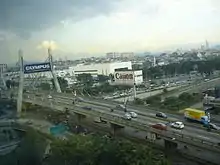 The cable-stayed bridge of Damansara–Puchong Expressway |
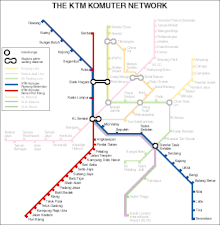 KTM Komuter network map |
MRT network
The MRT Sungai Buloh–Kajang line, or known as SBK Line, is the ninth rail transit line and the second fully automated and driverless rail system in the Klang Valley area, Malaysia after the Kelana Jaya Line. It is a part of Greater KL/Klang Valley Integrated Transit System. The line is numbered 9 and coloured Green on official transit maps. The first MRT line covers a span of 51 kilometres from Sungai Buloh to the Kajang, passing the Kuala Lumpur city centre where the alignment goes underground. The line will be serving a corridor with 1.2 million residents within the Klang Valley region from north-west to the south-east of Kuala Lumpur. The line starts from Sungai Buloh which is located to the north-west of Kuala Lumpur, which runs on an elevated guideway to the Semantan portal, passing through Kota Damansara, Bandar Utama, Seksyen 17 and Damansara Town Centre. Kwasa Damansara provides a cross-platform interchange between the SBK line and Sungai Buloh–Serdang–Putrajaya line (SSP line). The line continues in twin-bore tunnels to the Maluri portal, passing through the city centre and the Golden Triangle of Kuala Lumpur. Interchange to other lines is provided from Muzium Negara to Maluri with the exception of Cochrane in the Kuala Lumpur city. Beyond Taman Pertama, the line passes through Cheras and ends in Kajang via an elevated guideway. The line serves a corridor with an estimated population of 1.2 million people
The MRT Sungai Buloh–Serdang–Putrajaya line (MRT SSP) will be the twelfth rail transit line, the fourth fully automated and driverless rail system in Klang Valley area. It is a part of the larger rail transport system in Kuala Lumpur known as Greater KL/Klang Valley Integrated Transit System. The line is numbered 12 and coloured gold on transit maps.
It is one of three planned MRT rail lines under Klang Valley Mass Rapid Transit Project by MRT Corp. Phase 1 between Kwasa Damansara and Kampung Batu expected to be operational by July 2021. The remaining line is expected to be operational in 2022.
The approved rail alignment is 52.2 km in length, of which 13.5 km is underground. A total of 37 stations, 11 of which are underground, will be built. The line will stretch from Sungai Buloh to Putrajaya and will include densely populated areas Sri Damansara, Kepong, Batu, Jalan Sultan Azlan Shah, Jalan Tun Razak, KLCC, Tun Razak Exchange, Kuchai Lama, Seri Kembangan, and Cyberjaya. It is expected to have a ridership of 533,000 passengers per day once completed
Extensions to the LRT network
On 29 August 2006, Malaysian Deputy Prime Minister Mohd Najib Abdul Razak announced that the western end of the Kelana Jaya Line would be extended to the suburbs of Bandar Sunway, Subang Jaya, UEP Subang Jaya (USJ) and Putra Heights.[136] The extension will be part of a RM7 billion plan to expand Kuala Lumpur's public transport network.[137]
The expansion plan will also extend the Ampang Line to the suburb of Puchong and the south-west of Kuala Lumpur.[138] The plan also involves the construction of a new line, tentatively called the Kota Damansara-Cheras Line, which will run from Sungai Buloh in the north-western flank of the city, to Kajang.[134]
In September 2009, Syarikat Prasarana Negara began a public viewing of the details of the alignment of the Ampang Line and Kelana Jaya Line at various locations.[139] The public could provide feedback on the route during the three-month display period.[140] The extension will add 13 new stations and 17.7 kilometres (11.0 mi) of new track to the network. The new terminus will be at Putra Heights where the line will meet the Kelana Jaya Line and Ampang Line to provide a suburban interchange.[138] Construction began in mid 2013 and the project was fully operational by July 2016.[141]
- Public transport systems in Selangor
Education
Selangor has several tertiary education institutions, most of which are concentrated in major towns and cities. There are also many institutions of higher learning in the state, making Selangor's the largest higher education sector in Malaysia. Selangor also has the most universities—more than 20 public and private universities—in the country.
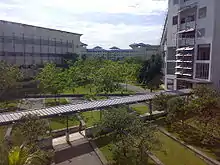

Public universities
| Name | Acronym | Foundation | Location |
|---|---|---|---|
| International Islamic University of Malaysia | IIUM | 1983 | Gombak |
| Universiti Teknologi MARA | UiTM | 1999 | Shah Alam & Puncak Alam |
| Universiti Kebangsaan Malaysia | UKM | 1970 | Bangi |
| Universiti Putra Malaysia | UPM | 1971 | Serdang |
Private universities and university colleges
International universities campus in Selangor
| Name | Acronym | Foundation | Location | From |
|---|---|---|---|---|
| Monash University Malaysia | Monash | 1998 | Subang Jaya | Australia |
| University of Nottingham Malaysia Campus | UNMC | 2000 | Semenyih | United Kingdom |
| Xiamen University Malaysia Campus | XMUMC | 2015 | Salak Tinggi | China |
Infrastructures and utilities
Electricity
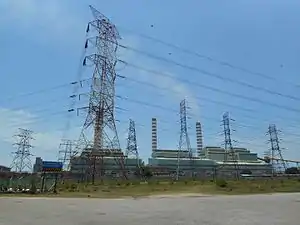
There are five main power stations in Selangor, namely; Sultan Salahuddin Abdul Aziz Shah Power Station, Connaught Bridge Power Station, Putrajaya Power Station, Kuala Langat Power Plant and Jimah Energy Ventures.[143]
Water supply
Selangor water works provides water supply in Selangor, Kuala Lumpur and Putrajaya. It was run by Syarikat Bekalan Air Selangor (SYABAS) which is owned by the state government. There are seven dams in Selangor; Sungai Selangor Dam, Sungai Tinggi Dam, Sungai Semenyih Dam, Sungai Langat Dam, Klang Gates Dam, Sungai Batu Dam, ORS Sungai Labu Dam and Tasik Subang Dam.[144]
Shopping Malls
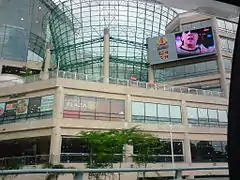
Notable shopping malls in Selangor include:
Hospitals
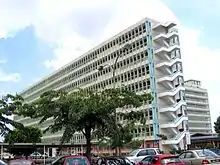
Notable public and private hospitals in Selangor include:
Public Hospitals
Private Hospitals
- Assunta Hospital
- Sunway Medical Centre
- Columbia Asia Hospital
Cuisine
The traditional Malay cuisine in Selangor has influences from Johor, Bugis, Jawa and Minangkabau.
Rojak Klang and Lontong Klang are famous cuisines in Klang and Shah Alam.[145][146] Other famous dishes include Mee Rebus,[147] Satay Kajang,[148] Nasi Ambeng,[149] Laksa Selangor, Soto (Soto Nasi Himpit and Mee Soto),[150] Sambal Tahun,[151][152] Bakso, Ketam Darul Ehsan, Ikan Masak Asam Pedas, Ayam Masak Kicap and Sayur Masak Rebung.[153]
Media
Television
Television in Selangor consists of seven free-to-air stations, one satellite television network and two internet television services. Three of the seven free-to-air stations are managed by Radio Televisyen Malaysia, a federal government-owned media company headquartered in Kuala Lumpur, while the four commercial stations are owned by Media Prima, an integrated media company headquartered in Bandar Utama, Selangor.[154][155] The satellite television service is owned by Astro All Asia Networks and it is available nationwide.[156] One of the Internet television services is owned by the state government of Selangor.[157]
| Type | Channels |
|---|---|
| Free-to-air | |
| Cable television | |
| Satellite television |
|
| Internet television |
|
Radio
Radio stations in Selangor are available in the FM and Shortwave frequencies and are transmitted from Gunung Ulu Kali, Selangor and Kajang, Selangor.[158][159]
There are a few types of radio stations operating in Selangor, namely, commercial radio stations, local community radio stations, federal government-owned radio stations, and specialized radio stations. Commercial radio stations available in Selangor are operated by media companies such as Astro Radio, Star Media Radio Group, Media Prima, Suara Johor and BFM Media. Local community radio stations are only available in certain regions. For example, UFM (93.6) operated by Universiti Teknologi MARA is only available in Shah Alam, Klang, and Petaling Jaya, while Putra FM (90.7) operated by Universiti Putra Malaysia is only available in Serdang and Seri Kembangan. Both radio stations target university students.
The nine Radio Televisyen Malaysia (RTM) radio networks available are Klasik FM, Muzik FM, Ai FM, Traxx FM, Minnal FM, Asyik FM, Selangor FM, KLFM, and Pahang FM. There are three specialised radio stations as well, namely IKIM.fm (91.5) operated by IKIM, Salam FM (102.5) operated by JAKIM, and Bernama Radio (93.9) operated by BERNAMA. The regions of Selangor that border other states can also receive two other Radio Televisyen Malaysia (RTM) radio stations; Perak FM (89.6 MHz/95.6 MHz; Selangor-Perak border) and Negeri FM (92.6 MHz; Selangor-Negeri Sembilan border).
Full list of radio stations available in Selangor:
| Frequency[160] | Station | Operator |
|---|---|---|
|
87.7 MHz |
Radio Klasik FM | RTM |
| 88.1 MHz | One FM | Media Prima |
|
88.5 MHz |
Nasional FM | RTM |
| 88.9 MHz | goXuan | Astro Radio |
|
89.6 MHz |
Perak FM | RTM |
|
89.7 MHz |
Ai FM | RTM |
| 89.9 MHz | BFM 89.9 | BFM Media |
|
90.3 MHz |
TraXX FM | RTM |
| 90.7 MHz | Putra FM | Universiti Putra Malaysia |
|
91.1 MHz |
Asyik FM | RTM |
| 91.5 MHz | IKIM.fm | Institut Kemajuan Islam Malaysia (IKIM) |
|
92.3 MHz |
Minnal FM | RTM |
| 92.6 MHz | Negeri FM | RTM |
| 92.9 MHz | Hitz | Astro Radio |
| 93.6 MHz | UFM | Universiti Teknologi MARA |
| 93.9 MHz | Bernama Radio | BERNAMA |
| 94.5 MHz | Mix | Astro Radio |
| 95.8 MHz | Fly FM | Media Prima |
| 96.7 MHz | Sinar | Astro Radio |
| 97.2 MHz | KL FM | RTM |
| 97.6 MHz | Hot FM | Media Prima |
| 98.8 MHz | 988 FM | Star Media Radio Group |
| 99.3 MHz | Raaga | Astro Radio |
| 100.9 MHz | Selangor FM | RTM |
| 101.3 MHz | Kool FM | Media Prima |
| 101.8 MHz | My | Astro Radio |
| 103.0 MHz | Melody | Astro Radio |
| 103.3 MHz | Era | Astro Radio |
| 104.1 MHz | Best FM | Suara Johor Sdn Bhd |
| 104.9 MHz | Zayan | Astro Radio |
| 105.3 MHz | Suria FM | Star Media Radio Group |
| 105.7 MHz | Lite | Astro Radio |
| 106.0 MHz | City Plus FM | Cense Media Sdn Bhd |
| 107.5 MHz | Pahang FM | RTM |
| 107.9 MHz | RAKITA | |
Newspapers
Mainstream newspapers in Selangor are:
- Berita Harian (in Bahasa Malaysia)
- Utusan Malaysia (in Bahasa Malaysia)
- Kosmo! (in Bahasa Malaysia)
- Harian Metro (in Bahasa Malaysia)
- Sinar Harian (in Bahasa Malaysia)
- Selangor Kini (in Bahasa Malaysia)
- New Straits Times (in English)
- The Star (in English)
- The Malay Mail (in English)
- The Sun (in English)
- Nanyang Siang Pau (in Mandarin)
- Sin Chew Daily (in Mandarin)
- China Press (in Mandarin)
- Malaysia Nanban (in Tamil)
- Tamil Nesan (in Tamil)
- Makkal Osai (in Tamil)
- Harakah (in Bahasa Malaysia and English). This newspaper is owned by the Pan-Malaysian Islamic Party, one of the major party in the Pakatan Rakyat ruling coalition in Selangor.
- Suara Keadilan. This newspaper is owned by People's Justice Party, another major party in the Pakatan Rakyat ruling coalition.
Image gallery

 Bangladeshi workers in Pasar Borong Selayang
Bangladeshi workers in Pasar Borong Selayang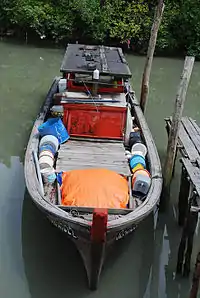 Pulau Ketam
Pulau Ketam.jpg.webp) Forest Research Institute of Malaysia (FRIM)
Forest Research Institute of Malaysia (FRIM) Gold Coast Morib
Gold Coast Morib
See also
- Selangor Sign Language
References
- "LAMBANG NEGERI SELANGOR". Selangor State Government (in Malay).
- "Laporan Kiraan Permulaan 2010". Jabatan Perangkaan Malaysia. p. 27. Archived from the original on 27 December 2010. Retrieved 24 January 2011.
- Department of Statistics Malaysia [@StatsMalaysia] (15 May 2018). "Malaysia population in Q1 2018 has increased by 1.3% compared to Q1 2017 to a total of 32.4 million population. #fanSTATStic" (Tweet). Retrieved 23 May 2018 – via Twitter.
- "Selangor". collinsdictionary.com. HarperCollins. Retrieved 23 January 2018.
- Nazli Ibrahim (18 December 2019). "Majlis Perbandaran Subang Jaya kini berstatus bandar raya". Selangor Kini. Retrieved 24 December 2019.
- "Bilangan PBT mengikut negeri dan taraf". One Stop Centre - Pihak Berkuasa Tempatan. Retrieved 11 November 2019.
- Nambiar, Predeep (16 September 2019). "Seberang Perai becomes country's largest city". Free Malaysia Today. Retrieved 11 November 2019.
- "GDP By State - National Accounts - 2010-2015". Department of Statistics, Malaysia. Department of Statistics, Malaysia. 30 September 2016. p. 10. Retrieved 3 May 2017. -- Select "Publication GDP by State 2010-2015.pdf" to download and view data
- Leete, Richard. "Selangor's Human Development Progress and Challenges" (PDF). UN Development Program. Archived from the original (PDF) on 25 April 2012. Retrieved 9 July 2011.
- "Kuala Selangor Info: Page 3 of 4: Oral History". Kuala Selangor District Council. Archived from the original on 3 August 2018.
- Tang Ruxyn (26 April 2017). "The Stories And Facts Behind How The 13 States of Malaysia Got Their Names". Says.
- "Info Kuala Selangor: Halaman 3 dari 4 - Cerita-Cerita Lisan". Majlis Daerah Kuala Selangor. Archived from the original on 8 December 2016.
- "bell". British Museum.
- Bernet Kempers, A. J. (1 January 1988). The Kettledrums of Southeast Asia: A Bronze Age World and Its Aftermath – August Johan Bernet Kempers – Google Books. ISBN 9789061915416. Retrieved 17 September 2013.
- W. Linehan (October 1951). "Traces of a Bronze Age Culture Associated With Iron Age Implements in the Regions of Klang and the Tembeling, Malaya". Journal of the Malayan Branch of the Royal Asiatic Society. Malaysian Branch of the Royal Asiatic Society. 24 (3 (156)): 1–59. JSTOR 41502997.
- R. O. Winstedt (October 1934). "A History of Selangor". Journal of the Malayan Branch of the Royal Asiatic Society. Malaysian Branch of the Royal Asiatic Society. 12 (3 (120)): 1–34. JSTOR 41559525.
- "Latar Belakang Kuala Selangor (Malay)". Kuala Selangor District Council. Archived from the original on 17 May 2009. Retrieved 7 June 2010.
- Tan Ding Eing (1975). A Portrait of Malaysia and Singapore. Oxford University Press. p. 81. ISBN 978-0195807226.
- Tan Ding Eing (1978). A Portrait of Malaysia and Singapore. Oxford University Press. p. 22. ISBN 978-0195807226.
- Jim Baker (15 July 2008). Crossroads (2nd Edn): A Popular History of Malaysia and Singapore. Marshall Cavendish International (Asia) Pte Ltd. pp. 64–65. ISBN 978-9814516020.
- Bungo, N.; Hussin, Nordin; Omar, Rahilah; Bidin, Aishah (September 2012). "Early settlements of the minangkabaus community in Selangor" (PDF). Pertanika Journal of Social Science and Humanities. 20 (3): 931–947.
- Jim Baker (15 July 2008). Crossroads (2nd Edn): A Popular History of Malaysia and Singapore. Marshall Cavendish International (Asia) Pte Ltd. p. 71. ISBN 978-9814516020.
- Tan Ding Eing (1975). A Portrait of Malaysia and Singapore. Oxford University Press. p. 74. ISBN 978-0195807226.
- J.M. Gullick (1983). The Story of Kuala Lumpur, 1857-1939. Eastern Universities Press (M). pp. 17–18. ISBN 978-9679080285.
- Paul H. Kratoska (2000). South East Asia, Colonial History: Peaceful transitions to independence (1945-1963). Routledge. p. 139. ISBN 978-0415247849.
- Benfield, H. Conway. "Handbook of The Federated Malay States" (PDF). sabrizain.org. Retrieved 23 January 2018.
- "The Birth of a Metropolis ..A Moment of History For All ". New Straits Times. 29 January 1974. Retrieved 25 October 2010.
- "Putrajaya milik Persekutuan, Selangor dibayar RM200 juta". Utusan Malaysia. 8 November 2000. Retrieved 23 May 2018.
- "PM isytihar Putrajaya sebagai Wilayah Persekutuan". Utusan Malaysia. 2 February 2001. Retrieved 23 May 2018.
- "Kawasan Hutan Simpanan kekal di Semenanjung Malaysia". data.gov.my. Forestry Department Peninsular Malaysia. Retrieved 16 July 2018.
- "JPSM Annual Report 2016 - page 99". www.forestry.gov.my. Jabatan Perhutanan Semenanjung Malaysia. Retrieved 17 July 2018.
- "Hutan Lipur & Hutan Taman Negeri". www.forestry.gov.my. Jabatan Perhutanan Semenanjung Malaysia. Retrieved 17 July 2018.
- "Senarai Hutan Lipur". forestry.selangor.gov.my. Jabatan Perhutanan Negeri Selangor. Retrieved 17 July 2018.
- "Akta Perhutanan Negara 1984". www.forestry.gov.my. Jabatan Perhutanan Semenanjung Malaysia. Retrieved 17 July 2018.
- "Jabatan Perhutanan Negeri". www.forestry.gov.my. Jabatan Perhutanan Semenanjung Malaysia. Retrieved 17 July 2018.
- "Forest Research Institute Malaysia | Official Portal". frim.gov.my. Retrieved 14 March 2014.
- "Forest Research Institute of Malaysia (FRIM), Kepong". tourismselangor.my. Retrieved 14 March 2014.
- "Sungai Dusun Wildlife Reserve, Selangor". www.wildlife.gov.my. Department of Wildlife and Natural Parks (PERHILITAN) Peninsular Malaysia. Retrieved 17 July 2018.
- "Kutu Hill Wildlife Reserve". www.wildlife.gov.my. Department of Wildlife and Natural Parks (PERHILITAN) Peninsular Malaysia. Retrieved 17 July 2018.
- "Sungai Puteh Hill Wildlife Reserve, Kuala Lumpur/Selangor". www.wildlife.gov.my. Department of Wildlife and Natural Parks (PERHILITAN) Peninsular Malaysia. Retrieved 17 July 2018.
- "Paya Indah Wetlands". www.tourismselangor.my. Tourism Selangor. Retrieved 17 July 2018.
- "Paya Indah Wetlands". www.nre.gov.my. Ministry of Land, Water and Natural Resources. Retrieved 17 July 2018.
- "Selangor Monthly Climate Averages". World Weather Online. Retrieved 5 July 2018.
- "Laporan Kiraan Permulaan 2010". Jabatan Perangkaan Malaysia. p. 25. Archived from the original on 27 December 2010. Retrieved 24 January 2011.
- "2010 Population and Housing Census of Malaysia" (PDF). Department of Statistics, Malaysia. p. 94. Archived from the original (PDF) on 5 February 2013.
- "Population by States and Ethnic Group". Department of Information, Ministry of Communications and Multimedia, Malaysia. 2015. Archived from the original on 12 February 2016. Retrieved 12 February 2015.
- "Pulau Carey". tourism.gov.my (in Malay). Lembaga Penggalakan Pelancongan Malaysia. Retrieved 23 May 2018.
- "2010 Population and Housing Census of Malaysia" (PDF). Department of Statistics, Malaysia. Archived from the original (PDF) on 22 May 2014. Retrieved 17 June 2012. p. 13
- Harding, Andrew (27 July 2012). "Chapter 8 - Religion and the Constitution". The Constitution of Malaysia: A Contextual Analysis. Hart Publishing. ISBN 9781847319838.
- "Amirudin angkat sumpah MB Selangor, Rodziah dilantik EXCO". Berita Harian. 19 June 2018. Retrieved 19 June 2018.
- See Article 38, 39, 48(1) and 50 of the Constitution
- "Undang-undang Tubuh Negeri Selangor". dewan.selangor.gov.my. Dewan Negeri Selangor. Retrieved 16 April 2018.
- Kee, Hua Chee (8 March 2003). "Fulfilling a Ruler's destiny". The Star (Malaysia). Archived from the original on 18 October 2012. Retrieved 3 June 2011.
- "Laporan Tinjauan Kajian Rancangan Struktur Negeri Selangor 2035 - A2 : Penduduk dan Perancangan Sumber Manusia" (PDF) (in Malay). p. A2-3. Archived from the original (PDF) on 24 January 2018. Retrieved 24 January 2018.
- "Portal Rasmi PDT Gombak Profil Gombak". ww2.selangor.gov.my. Retrieved 24 January 2018.
- "Portal Rasmi PDT Hulu Langat Latar Belakang". ww2.selangor.gov.my. Retrieved 24 January 2018.
- "Sungai Congkak Recreational Forest". malaysia-traveller.com. Retrieved 24 January 2018.
- "Gabai Waterfall, Hulu Langat". tourismselangor.my. Retrieved 24 January 2018.
- "Portal Rasmi PDT Hulu Selangor Guna Tanah". ww2.selangor.gov.my. Retrieved 24 January 2018.
- "Bukit Kutu (Gunung Kutu)". tourismselangor.my. Retrieved 24 January 2018.
- "Kerling Hot Spring". tourismselangor.my. Retrieved 24 January 2018.
- "Klang District Background". luas.gov.my. Retrieved 24 January 2018.
- "Little India, Jalan tengku Kelana". tourismselangor.my. Retrieved 24 January 2018.
- "Portal Rasmi PDT Kuala Langat Profil Kuala Langat". ww2.selangor.gov.my. Retrieved 24 January 2018.
- "Laporan Profil Daerah - Jabatan Pengairan dan Saliran Daerah Kuala Selangor" (PDF). apps.water.gov.my. p. 7. Retrieved 24 January 2018.
- "Kuala". glosbe.com. Retrieved 24 January 2018.
- "Kuala Selangor - The Land of History, Firefly, Seafood And Eagle". Archived from the original on 13 September 2017. Retrieved 24 January 2018.
- "Malawati Hill". tourismselangor.my. Retrieved 24 January 2018.
- "Kampung Kuantan Fireflies". tourismselangor.my. Retrieved 24 January 2018.
- "Portal Rasmi PDT Petaling Sejarah Daerah Petaling". ww2.selangor.gov.my. Retrieved 24 January 2018.
- "Sejarah Ringkas Daerah Petaling". ww2.selangor.gov.my (in Malay). Retrieved 24 January 2018.
- "Portal Rasmi PDT Sabak Bernam Profil Daerah". ww2.selangor.gov.my. Retrieved 24 January 2018.
- "Sejarah Ringkas Daerah Sabak Bernam". ww2.selangor.gov.my (in Malay). Retrieved 24 January 2018.
- "Sekinchan Paddy Field". tourismselangor.my. Retrieved 24 January 2018.
- "Portal Rasmi PDT Sepang Data Keluasan". ww2.selangor.gov.my. Retrieved 24 January 2018.
- "Sejarah Daerah Sepang". ww2.selangor.gov.my. Retrieved 24 January 2018.
- "Senarai PBT di Malaysia - Selangor". Archived from the original on 15 December 2017. Retrieved 24 January 2018.
- "Majlis Bandaraya Petaling Jaya". Retrieved 24 January 2018.
- "Majlis Bandaraya Shah Alam". Retrieved 24 January 2018.
- "Majlis Perbandaran Subang Jaya". Retrieved 24 January 2018.
- "Majlis Daerah Hulu Selangor". Retrieved 24 January 2018.
- "Majlis Daerah Sabak Bernam". Retrieved 24 January 2018.
- "Majlis Perbandaran Ampang Jaya". Retrieved 24 January 2018.
- "Majlis Perbandaran Kajang". Retrieved 24 January 2018.
- "Majlis Perbandaran Klang". Retrieved 24 January 2018.
- "Majlis Daerah Kuala Langat". Retrieved 24 January 2018.
- "Majlis Daerah Kuala Selangor". Retrieved 24 January 2018.
- "Majlis Perbandaran Selayang". Retrieved 24 January 2018.
- "Majlis Perbandaran Sepang". Retrieved 24 January 2018.
- "Selangor Maju Criteria". Bernama. Archived from the original on 10 April 2007. Retrieved 10 June 2009.
- "Najib: Selangor's Development Due To Leadership And Cooperation". Bernama. 26 August 2005. Retrieved 9 June 2009.
- "Briefing on - Community | The Star Online". www.thestar.com.my. Retrieved 30 July 2018.
- "Portal Kerajaan Negeri Selangor Darul Ehsan". www.selangor.gov.my. Retrieved 30 July 2018.
- "PROTON Holdings Berhad - Shah Alam Plant - Overview". corporate.proton.com. Archived from the original on 31 July 2017. Retrieved 17 January 2017.
- "PROTON Holdings Berhad - Tanjung Malim Plant - Overview". corporate.proton.com. Archived from the original on 8 August 2017. Retrieved 17 January 2017.
- "Perusahaan Otomobil Kedua". perodua.com.my. Retrieved 23 January 2018.
- "Toyota Motor Corporation Global Website - 75 Years of Toyota - Activities by Region - Asia". toyota-global.com. Toyota Motor Corporation. Archived from the original on 21 November 2015. Retrieved 22 November 2015.
- "UMW Holdings Berhad - Corporate presentation - March 2017" (PDF). ir.chartnexus.com. March 2017. Archived from the original (PDF) on 8 October 2017. Retrieved 23 January 2018.
- "Tan Chong Motor Holdings Berhad". tanchong.com.my. Retrieved 23 January 2018.
- Ng, Chris (6 September 2012). "Tan Chong Motor Assemblies Serendah plant tour – take a look at where the Nissan Almera is made". paultan.org. Retrieved 23 January 2018.
- Ng, Chris (7 September 2016). "Take a look inside the oldest car factory in Malaysia Part 1"". carmalaysia.my. Archived from the original on 14 June 2017. Retrieved 14 June 2017.
- Daniel Khoo (20 October 2012). "Volvo chooses Malaysia as Asean manufacturing hub". The Star Online. Archived from the original on 21 October 2012. Retrieved 14 June 2017.
- Chris Yap (6 August 2013). "The models built in Malaysia and where they are built". motortrader.com.my. Archived from the original on 22 November 2015. Retrieved 23 January 2018.
- "Lloyd's List Top 100 Ports | Maritime Intelligence". Retrieved 16 May 2018.
- "11 - Port Klang Malaysia". Maritime Intelligence. 2 August 2017. Retrieved 23 May 2018.
- "GDP for Selangor by Kind of Economic Activity, 2010-2016 at Constant 2010 Prices" (PDF). dosm.gov.my. Department of Statistics Malaysia. Retrieved 23 May 2018.
- "Selangor Fruit Valley". pkps.gov.my. Selangor Agricultural Development Corporation. Retrieved 23 May 2018.
- "Sawah padi diserang hawar daun bakteria". www2.selangor.gov.my/sabakbernam.php. Pejabat Daerah dan Tanah Sabak Bernam. Retrieved 23 May 2018.
- "Tanaman Getah Balak". pkps.gov.my. Selanngor Agricultural Development Program. Retrieved 23 May 2018.
- "Ladang Kelapa Sawit". pkps.gov.my. Selangor Agricultural Development Corporation. Retrieved 23 May 2018.
- "i-City, Shah Alam". Tourism Selangor. Retrieved 13 April 2018.
- "About Us". zoonegaramalaysia.my. Zoo Negara. Retrieved 29 December 2010.
- "Sepang Circuit". sepangcircuit.com. Retrieved 13 April 2018.
- "Sultan Salahuddin Abdul Aziz Shah Mosque". Tourism Malaysia. Archived from the original on 24 May 2014. Retrieved 23 May 2014.
- "Internationally Known as One of The Best Malaysia Destinations". Sunway Group. Archived from the original on 26 July 2015. Retrieved 24 October 2016.
- "Selangor allowed 4,000 massage parlours'". Retrieved 19 August 2012.
- "Six mainland Chinese women believed to be prostitutes were detained in a raid at the Kepong Sentral Condominium, here yesterday. Read more: Police detain 6 women in raid on prostitution den". NST Malaysia. Archived from the original on 2 September 2012.
- "Perasmian Lebuhraya Baru Lembah Klang". Hari Ini Dalam Sejarah. National Archives of Malaysia. 11 January 1993. Archived from the original on 25 September 2015. Retrieved 24 September 2015.
- Rosmiza Kasim (22 April 2017). "Tiada lagi bayaran tunai". Sinar Harian. Retrieved 23 May 2018.
- "About KLIA - Malaysia Airports Holdings Berhad". klia.com.my. Retrieved 23 May 2018.
- "The Rise of A New Titan". klia.com.my. Malaysia Airports Holdings Berhad. Retrieved 23 May 2018.
- "Sypark Terminal Sultan Abdul Aziz Shah Airport". malaysiaairports.com.my. Retrieved 23 May 2018.
- "Subang Airport". wonderfulmalaysia.com. Retrieved 23 May 2018.
- "Klang Sentral Bus Terminal". catchthatbus.com. Retrieved 31 May 2018.
- "Kompleks Perhentian Kajang Bus Terminal". catchthatbus.com. Retrieved 31 May 2018.
- "One Utama Bus Transportation Hub". catchthatbus.com. Retrieved 31 May 2018.
- "Terminal Bas Express Seksyen 13 Shah Alam". catchthatbus.com. Retrieved 31 May 2018.
- "Rapid KL - Bus Routes". myrapid.com.my. Rapid KL. Retrieved 31 May 2018.
- "Senarai Pengusaha Bas Henti-henti di Setiap Negeri". spad.gov.my. Land Public Transport Commission of Malaysia. Archived from the original on 2 August 2018. Retrieved 31 May 2018.
- "Khidmat Bas Selangorku Percuma - Inisiatif Peduli Rakyat". ipr.selangor.gov.my. Selangor State Government. Retrieved 31 May 2018.
- "Perkhidmatan Bas Selangorku". selangor.gov.my. Selangor State Government. Retrieved 31 May 2018.
- Lizawati Madfa; Sheeda Fathil (7 November 2017). "Aplikasi SITS bas Smart Selangor boleh dimuat turun". Selangorkini. Retrieved 31 May 2018.
- "History of Railways in Selangor". Retrieved 23 July 2017.
- "MRT". Archived from the original on 15 May 2015. Retrieved 24 April 2015.
- "LRT". MyRapid (Syarikat Prasarana Negara Berhad). Archived from the original on 2 February 2014. Retrieved 28 April 2014.
- Mergawati Zulfakar (30 August 2006). "Rail travel expansion". thestar.com.my. Retrieved 23 May 2018.
- "RM7bn LRT Extension". The Star. 15 September 2009.
- "George Kent-Lion Pacific JV gets Ampang Line extension job". thesundaily.my. 31 July 2012. Retrieved 23 May 2018.
- transitmy. "MRT Update: MyRapidTransit launching & public viewing on 8 July 2011 at KL Convention Centre". Malaysian Transit. Archived from the original on 20 July 2012. Retrieved 11 July 2011.
- "Public May Give Feedback on LRT Extension Project". The New Straits Times. 14 September 2009. Archived from the original on 22 September 2009. Retrieved 15 September 2009.
- "LRT Kelana Jaya Line Extension Opening As Scheduled on 30 June". myRapid. 14 April 2016. Archived from the original on 19 April 2016.
- "UNISEL". unisel.edu.my. Archived from the original on 27 May 2011. Retrieved 24 January 2018.
- "Performance and Statistical Information on Electricity Supply Industry in Malaysia". meih.st.gov.my. Malaysia Energy Information Hub. p. 43. Retrieved 31 May 2018.
- "Air Untuk Selangor" (PDF). syabas.com.my. Syarikat Bekalan Air Selangor. Retrieved 31 May 2018.
- Edward Rajendra (14 January 2016). "Best-kept family secret - Eat & Drink". thestar.com.my. Retrieved 1 June 2018.
- "Lontong Klang sediakan lontong sedap pilihan ramai sejak 1970". Myselera.com. 15 October 2016. Retrieved 1 June 2018.
- Patrick Pillai (2015). Yearning to Belong: Malaysia's Indian Muslims, Chitties, Portuguese Eurasians, Peranakan Chinese and Baweanese (Illustrated ed.). ISEAS-Yusof Ishak Institute. p. 19. ISBN 9789814519670.
- Mohd Hafiz Ismail; Sharifudin Abdul Rahim (16 February 2014). "Sejarah bermulanya Sate Kajang". Sinar Harian. Retrieved 1 June 2018.
- "Communal dish". thestar.com.my. 24 August 2010. Retrieved 1 June 2018.
- Sarah Hazimi (13 July 2017). "Hearty soto served with chicken pieces". thestar.com.my. Retrieved 2 June 2018.
- "Pedas hingga telinga berdesing". Kosmo!. Retrieved 2 June 2018.
- Nor Hanisah Kamaruzaman (13 May 2016). "Keunikan jeli kulit lembu". Harian Metro. Retrieved 2 June 2018.
- Betty Saw (15 September 2014). Best of Malaysian Cooking. Marshall Cavendish International Asia Pte Ltd. pp. 89–127. ISBN 978-981-4561-98-3.
- "Peranan 169 saluran televisyen sokong agenda negara". Utusan Malaysia. 27 December 2005. Retrieved 18 July 2018.
- Abd Aziz Itar; Wanda Idris (8 May 2006). "Hala tuju stesen-stesen tv media prima". Utusan Malaysia. Retrieved 18 July 2018.
- Michael Cheang (13 October 2016). "Astro celebrates 20th year of business". The Star (Malaysia). Retrieved 18 July 2018.
- "Laman web TV Selangor digodam". Malaysiakini. 31 March 2011. Retrieved 18 July 2018.
- BERNAMA (17 April 2017). "95 Peratus Kawasan Berpenduduk Di Pahang Bakal Terima Akses TV Digital Menjelang Hujung Tahun Ini". kpdnkk.bernama.com. Kementerian Perdagangan Dalam Negeri, Koperasi dan Kepenggunaan. Retrieved 18 July 2018.
- "Perasmian stesen pemancar seberang laut radio Malaysia, Kajang". hids.arkib.gov.my. Arkib Negara. 29 April 1967. Retrieved 18 July 2018.
- "Stesen radio di Kuala Lumpur". worldradiomap.com. World Radio Map. Retrieved 18 July 2018.
External links
| Wikimedia Commons has media related to Selangor. |
- Official website
- Rail map of Klang Valley
- Geographical maps of Selangor
- History of Selangor
- Official Website of Online Shopping & Great Deals in Selangor, Malaysia - Everydayonsales
- Malaysia No 1 Warehouse Sale, Promotions & Bargain Deals Website - ShoppingNSales
- Tourism Selangor Official Website
- Invest Selangor Berhad Official Website
- Visit Selangor

